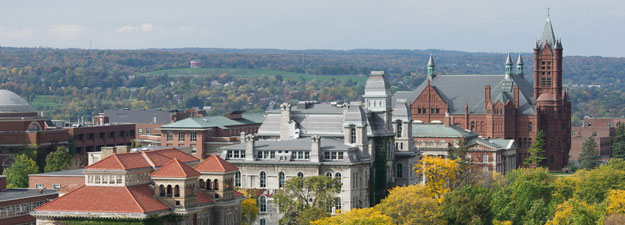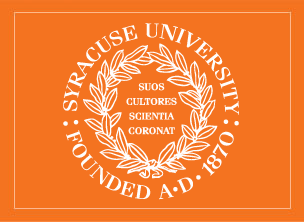Academic Ceremony and Traditions
Charter Mace
Regal and bold in appearance, the Charter Mace has opened Syracuse University academic processions since its first appearance at the 1959 Commencement ceremonies. The mace is an ancient symbol of authority, representing the University’s mission and integrity.
Gordon D. Hoople G’49, a former trustee and medical director of the University’s Hearing and Speech Center, commissioned the 3 1/2-foot, sterling silver mace with inlaid carnelian and lapis lazuli stones to replace an unadorned wooden one. The vibrant stones from India and Brazil emblematize the school color and the University’s international character.
Heraldic inscriptions on the mace signify Syracuse traditions and the University’s relationship with the City of Syracuse and the State of New York. A circuit rider on horseback represents ties with the Methodist clergy who founded the University in 1870; the Latin word Communitas—meaning “community” or “fellowship”—describes the relationship between the University and the City of Syracuse; and the inscription of New York State’s motto, Excelsior—meaning “higher”— aligns the University with the state’s goals.
A top the mace appears a campfire, symbolizing the University’s role to provide the light of knowledge and its aim to respect the historic role played by the Onondaga Nation in Central New York. Known as the fire keepers of the Haudenosaunee Confederacy, the Onondagas were the first in the region to pursue the path of enlightenment through peace and democracy more than 600 years ago.
Chancellor’s Medallion
The Chancellor’s Medallion is the official symbol of the Syracuse University Office of the Chancellor and President. Created in 1970 by John C. Marshall, an internationally known silversmith and former Syracuse University faculty member, the medallion is designed to be worn with academic dress at official University functions.
The medallion consists of two parts: the upper round coin, containing a stylized “Lamp of Learning” and the words “Syracuse University”; and the lower main form, which incorporates the University motto, Suos Cultores Scientia Coronat, or “Knowledge crowns those who seek her.” The coin and lower main form are hand-shaped and soldered to achieve a raised effect. A wreath, created by a unique granulation process, encircles the motto. A hand-woven, loop-in-loop chain consisting of more than 1,300 separate links holds the medallion. This chain-making process is modeled after the weave used by ancient Greeks and Etruscans. Upon retirement, each Chancellor receives a separate replica of the upper coin that bears the Chancellor’s name and years of service on the reverse side.
Academic Attire
Academic caps, gowns, and hoods date back to the Middle Ages when monks and students wore them as a shield against the dampness and drafts of 12th-century castles and monasteries. Bachelor’s degree gowns have a semi-stiff yoke, long pleated front, and intricate shirring across the shoulders and back. The gown—which may be worn open or closed—is distinguished by its long, pointed sleeves. Master’s degree gowns are worn open. The very long sleeves are square and closed at the end, the forearm coming through a slit near the elbow. Doctoral degree gowns carry broad velvet panels down the front and three velvet bars on full, round, open sleeves. This trimming may be black or a color representing a specific discipline. Doctors’ caps may be velvet and the tassels gold.

